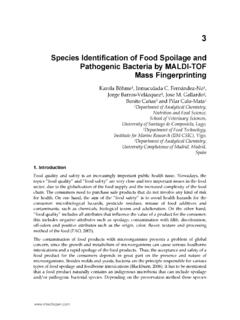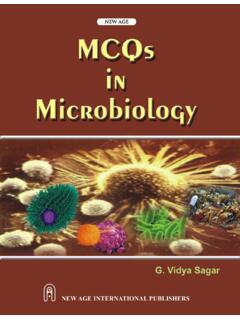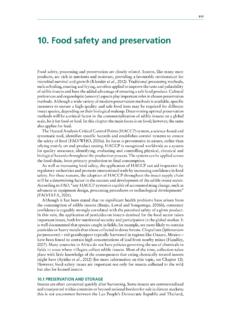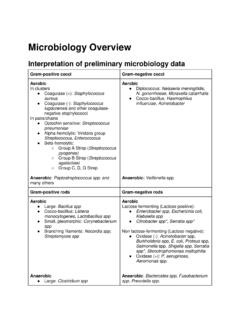Transcription of Acute Diarrhea in Adults - AAFP Home
1 180 American Family Physician Volume 89, Number 3 February 1, 2014 Acute Diarrhea in AdultsWENDY BARR, MD, MPH, MSCE, and ANDREW SMITH, MD Lawrence Family Medicine Residency, Lawrence, Massachusettscute Diarrhea is defined as stool with increased water content, volume, or frequency that lasts less than 14 Diarrheal illness accounts for million deaths per year In the United States, an estimated 48 mil-lion foodborne diarrheal illnesses occur annually, resulting in more than 128,000 hospitalizations and 3,000 ,4 In the developing world, infectious causes of Acute Diarrhea are largely related to con-taminated food and water In the developed world, technological progress and an increase in mass production of food have paradoxically contributed to the persistence of foodborne illness, despite higher stan-dards of food Differential DiagnosisInfectious causes of Acute Diarrhea include viruses, bacteria, and, less often, parasites.
2 Noninfectious causes include medication adverse effects, Acute abdominal processes, gastroenterologic disease, and endocrine disease. Clinically, Acute infectious Diarrhea is clas-sified into two pathophysiologic syndromes, commonly referred to as noninflammatory (mostly viral, milder disease) and inflamma-tory (mostly invasive or with toxin-produc-ing bacteria, more severe disease).7, 8 Ta b l e 1 compares noninflammatory and inflamma-tory Acute infectious , 8 Viral infections are the most common cause of Acute Bacterial infec-tions are more often associated with travel, comorbidities, and foodborne illness.
3 When a specific organism is identified, the most common causes of Acute Diarrhea in the United States are Salmonella, Campylobacter, Shigella, and Shiga toxin producing Esche-richia coli (enterohemorrhagic E. coli).10 The Centers for Disease Control and Prevention provides a comprehensive list of foodborne illnesses at and Physical ExaminationHISTORYThe onset, duration, severity, and frequency of Diarrhea should be noted, with particu-lar attention to stool character ( , watery, bloody, mucus-filled, purulent, bilious).
4 The patient should be evaluated for signs of dehydration, including decreased urine out-put, thirst, dizziness, and change in mental status. Vomiting is more suggestive of viral illness or illness caused by ingestion of a preformed bacterial toxin. Symptoms more suggestive of invasive bacterial (inflamma-tory) Diarrhea include fever, tenesmus, and grossly bloody Diarrhea in Adults is a common problem encountered by family physicians. The most common etiology is viral gastroenteritis, a self-limited disease.
5 Increases in travel, comorbidities, and foodborne illness lead to more bacteria-related cases of Acute Diarrhea . A history and physical examination evaluating for risk factors and signs of inflammatory Diarrhea and/or severe dehydration can direct any needed testing and treatment. Most patients do not require labora-tory workup, and routine stool cultures are not recommended. Treatment focuses on preventing and treating dehydra-tion. Diagnostic investigation should be reserved for patients with severe dehydration or illness, persistent fever, bloody stool, or immunosuppression, and for cases of suspected nosocomial infection or outbreak.
6 Oral rehydration therapy with early refeeding is the preferred treatment for dehydration. Antimotility agents should be avoided in patients with bloody Diarrhea , but loperamide/simethicone may improve symptoms in patients with watery Diarrhea . Probiotic use may shorten the duration of illness. When used appropriately, antibiotics are effective in the treatment of shigellosis, campylobacteriosis, Clostridium difficile, traveler s Diarrhea , and protozoal infections. Prevention of Acute Diarrhea is promoted through adequate hand washing, safe food preparation, access to clean water, and vaccinations.
7 (Am Fam Physician. 2014;89(3):180-189. Copyright 2014 American Academy of Family Physicians.)CME This clinical content conforms to AAFP criteria for continuing medical education (CME). See CME Quiz Questions on page disclosure: No rel-evant financial affiliations. Patient information: A handout on this topic, written by the authors of this article, is available at / 2014 / 0201/ p180 -s1. AScan the QR code below with your mobile device for easy access to the patient information hand-out on the AFP mobile from the American Family Physician website at Copyright 2013 American Academy of Family Physicians.
8 For the private, noncom-mercial use of one individual user of the website. All other rights reserved. Contact for copyright questions and/or permission DiarrheaFebruary 1, 2014 Volume 89, Number 3 American Family Physician 181A food and travel history is helpful to evaluate poten-tial exposures. Children in day care, nursing home resi-dents, food handlers, and recently hospitalized patients are at high risk of infectious diarrheal illness. Pregnant women have a 12-fold increased risk of listeriosis,12 which is primarily contracted by consuming cold meats, soft cheeses, and raw Recent sick contacts and use of antibiotics and other medications should be noted in patients with Acute Diarrhea .
9 Sexual practices that include receptive anal and oral-anal contact increase the possibility of direct rectal inoculation and fecal-oral transmission. The history should also include gastroenterologic disease or surgery; endocrine disease; radiation to the pelvis; and factors that increase the risk of immuno-suppression, including human immunodeficiency virus infection, long-term steroid use, chemotherapy, and immunoglobulin A deficiency. History findings associ-ated with causes of Diarrhea are summarized in Ta b l e 2,1,7,8,14,15 and clinical features by pathogen are summa-rized in Ta b l e ,14 PHYSICAL EXAMINATIONThe primary goal of the physical examination is to assess the patient s degree of dehydration.
10 Generally ill appear-ance, dry mucous membranes, delayed capillary refill time, increased heart rate, and abnormal orthostatic vital signs can be helpful in identifying more severe dehydration. Fever is more suggestive of inflammatory Diarrhea . The abdominal examination is important to assess for pain and Acute abdominal processes. A rectal examination may be helpful in assessing for blood, rectal tenderness, and stool TestingBecause most watery Diarrhea is self-limited, testing is usually not ,16 In general, specific diagnostic investigation can be reserved for patients with severe dehydration, more severe illness, persistent fever, bloody stool, or immunosuppression, and for cases of suspected nosocomial infection or BLOODIt is unclear how much fecal occult blood testing affects pretest probability.
















